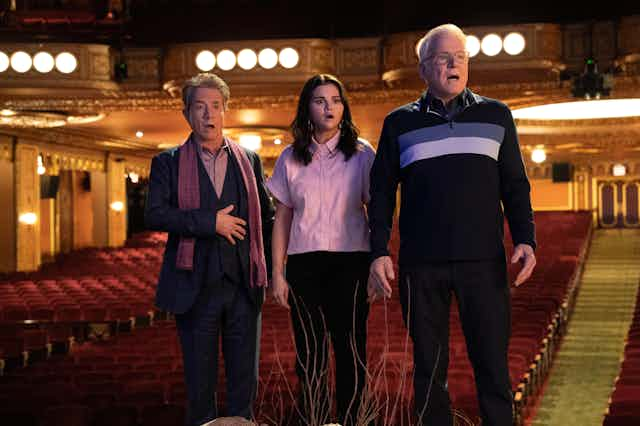Only Murders in the Building, starring Steve Martin, Martin Short and Selena Gomez, has returned for a third season on Disney+. The popular series follows the whodunit mystery formula, beginning with a murder in the apartment building the characters live in, the perpetrator of which the three sleuths must work out by the series’ end.
Much of the innovation of Only Murders lies in its incorporation of the true crime podcast with the familiar whodunit formula.
The whodunit is not easily combined with the true crime format. True crime narratives search for their killers in communities of thousands, whereas the whodunit works with a strictly limited number of suspects. True crime stories often turn on an accident or chance events, which would feel unsatisfying within the structure of a cosy detective novel. And true crime narratives always involve difficult ethical implications,, whereas the fictional whodunit often works to represent murder as artistically pleasing.
Another way of putting this is that while true crime is tragedy, the whodunit is comedy. It often makes use of irrational situations and explanations. Its detectives are sometimes ridiculous figures who use their absurdity (or, in the case of Only Murders, are simply absurd) to disarm suspicion and physical violence is downplayed. Most importantly, in a whodunit everything is resolved – we know the killer will be caught.
In his essay The Guilty Vicarage (1948), the poet W. H. Auden argues that the whodunit actually resembles a tragedy in the way it offers readers a cathartic experience of violence. But this transgression is neutralised by the eventual identification of the murderer, an act which not only provides narrative closure but also implies the innocence of the rest of the cast.
But more recent criticism has challenged this reading of the genre, arguing that the resolutions of whodunits inevitably have loose ends, or leave tricky ethical questions unanswered.
Although the plot of Only Murders in the Building borrows the tropes of the whodunit, it is far from a conventionally cosy crime caper.
Playing the Game
In 1929, the critic Ronald Knox devised his ten commandments for the detective writer.
Knox’s rules were satirical, poking fun at the cliches of the interwar whodunit (for instance, his rule that “no Chinaman must figure in the story” satirised the tendency of interwar popular fiction to include depictions of Asian villainy). But Only Murders deliberately breaks many of Knox’s injuctions.
For instance, Knox rules that “not more than one secret room or passage is allowable”. Of course, the Arconia – the building the murders happen in – is riddled with such passages.
The rules likewise state that the murderer “must not be anyone whose thoughts the reader has been allowed to follow”, a law broken in season two when the murderer (spoiler ahead) is one of the people investigating the murder and from whose perspective we get an insight.
Perhaps most comically, Knox’s injunction against the cliched use of identical twins in detective fiction is subverted in Only Murders by the appearances of Charles’ stunt double Sazz Pataki (Jane Lynch), who even in everyday life never fails to be coincidentally wearing exactly the same outfit as Charles.
Knox’s rules, though tongue in cheek, reinforced a sense of the importance of “fair play” between author and reader. The murderer must be someone we know, with clues fairly displayed so that the reader might have a chance of reaching the conclusion before the detective.
The fact that Only Murders gleefully undermines these rules reflects the fact that its real pleasure is not in the mystery itself, since viewers cannot compete with Charles, Oliver and Mabel. We don’t have the information required to decode the meaning of the victim’s last words “14 Savage” in season two, for instance. But, whereas in the traditional whodunit this might considered a weakness, in Only Murders it becomes an advantage because we realise it is the genre itself being parodied.
An early 20th-century sensibility
The appeal of the show is not, then, in trying to work out whodunit, but in enjoying its convoluted plots.
The finale of season two, for instance, provides a dizzying succession of twists, identifying three potential murderers in rapid succession. When the real murderer is revealed, we gasp not because we overlooked some vital clue but at the audacity of the plotting.
For all its postmodern self referential trappings and awareness of contemporary fan cultures, Only Murders’ main use of the whodunit is as a historical reference to the early 20th century. The popularity of Agatha Christie was, after all, contemporary with the rise of the kind of Broadway musical Oliver attempts to direct in season three. The clash of genres in Only Murders is self-consciously reflected in Oliver’s decision to transform his play Death Rattle from a psychological thriller to a musical.
The theatrical setting of season three also looks back to a tradition of interwar whodunits set in the theatre. Novels such as Ngaio Marsh’s Vintage Murder (1937), Margery Allingham’s Dancers in Mourning (1937) and Ellery Queen’s The Roman Hat Mystery (1929) take place on, or around, the stage. The theatre setting makes explicit what is implicit in the whodunit: that we are watching a performance that is not entirely truthful.
These references to early 20th century culture emphasise the importance of the Arconia itself to the show. Like the whodunit form, it is an early 20th century structure the characters find themselves getting lost in. Only Murders in the Building season three is a loving tribute to this golden age of mystery and eccentric theatricality of it.

Looking for something good? Cut through the noise with a carefully curated selection of the latest releases, live events and exhibitions, straight to your inbox every fortnight, on Fridays. Sign up here.

